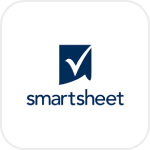
- Overview
- Configuration
Smartsheet
Automate user account management in Smartsheet with ADManager Plus integration
Smartsheet is an enterprise work execution software designed to manage and scale projects. Integrating Smartsheet with ADManager Plus enhances user lifecycle management, from onboarding to offboarding. This integration allows IT teams to automate the creation of user accounts in Smartsheet, ensuring that employees have access to the required resources to perform their tasks throughout their tenure. Furthermore, when employees leave the organization, their access to Smartsheet can be promptly revoked, reducing manual identity management tasks and simplifying coordination between HR and IT departments.
Enable seamless user creation
Initiate the creation of Smartsheet accounts for new hires automatically, granting them necessary accesses and ensuring immediate productivity.
Safe user offboarding
Revoke access privileges and disable or delete accounts of employees departing the organization to streamline the offboarding process.
How to integrate ADManager Plus and Smartsheet
Prerequisites:
- Smartsheet uses OAuth 2.0 to authorize API requests.
- Requires client_id and client_secret for authorization.
Privileges:
- To import users (Inbound action): Ensure the account used for authorization has permission to read all user accounts.
- To perform any action or query in Smartsheet (Outbound Action): Ensure the account used for authorization has permission to perform the desired action in Smartsheet.
Authorization configuration
- Log in to ADManager Plus and navigate to the Automation tab.
- In the left pane, under Configuration, click Application Integrations.
- Under Enterprise Applications, click Smartsheet.
- Toggle the Enable Smartsheet Integration button on.
- In the Smartsheet Configuration page, click Authorization.
- Perform steps to generate client_id and client_secret from Smartsheet, and paste them in the respective value fields.
- Click Configure.
Inbound webhook configuration
Inbound webhook enables you to fetch user data from Smartsheet to ADManager Plus. The attribute mapping configured in this section can be selected as the data source during automation configuration.
To configure an inbound webhook for Smartsheet:
- Under Inbound Webhook, click Smartsheet Endpoint Configuration.
- In the Endpoint Configuration tab, an endpoint, Smartsheet USERS ENDPOINT, pre-configured with an Endpoint URL, API Method, Headers, and Parameters fields to fetch user accounts from Smartsheet. If you would like to use this pre-configured endpoint, replace {subdomain} with the domain name of your Smartsheet instance in the Endpoint URL field. However, if you would like to use a new endpoint to import users, you can configure one using the + Add API endpoint button and filling in the required fields as per Smartsheet's API references. Click here to learn how.
- The API key value pair is pre-configured as a header for authenticating API requests as configured during Authorization Configuration.
- Macros: You can add macros to your endpoint configuration to dynamically change it as per your requirement using the macro chooser component.
- Refer to Smartsheet's API references and configure additional headers and parameters, if required.
- In the Settings tab, the Repeat Calling This Endpoint option has been enabled by default to repeatedly call the API until you get all the required data. The Repeat Call Configuration has been pre-configured to increase the page parameter value by 1 to fetch 100 objects in each API endpoint call. In the Repeat Call Criteria field, the condition has been pre-configured to repeat the API call until the response has no values.
- Once done, click Test & Save. A response window will display all the requested parameters that can be fetched using the API call. Click Proceed.
- Refer to Smartsheet's API references to know the Parameters that must be configured to fecth only specific parameters.
- You can configure multiple endpoints for Smartsheet using the + Add API endpoint button. Click here to learn how.
- Click Data Source - LDAP Attribute Mapping to match endpoints and to map AD LDAP attributes with the respective attributes in Smartsheet.
- Click + Add New Configuration and perform the following:
- Enter the Configuration Name and Description and select the Automation Category from the drop-down menu.
- In the Select Endpoint field, select the desired endpoint and a Primary Key that is unique to a user (e.g. employeeIdentifier). Note: When multiple endpoints are configured, this attribute must hold the same value in all the endpoints.
- In the Attribute Mapping field, select the attribute from the LDAP Attribute Name drop-down menu and map it with the respective column in Smartsheet.
- If you would like to create a new custom format for this, click Format Mapping Attribute.
- Click Save.
Note:
Note:
Outbound webhook configuration
Outbound webhook enables you to update the changes made in AD using ADManager Plus to Smartsheet..
The webhooks configured in this section can be used in Orchestration Templates for scheduled or event-driven automation, allowing management actions to be performed on a group of users.
To configure an outbound webhook for Smartsheet:
- Under Outbound Webhook, click Smartsheet Webhook Configuration.
- Click + Add Webhook.
- Enter a name and description for this webhook.
- Decide on the action that has to be performed and refer to Smartsheet's API references for the API details such as URL, and the headers, parameters, and other requirements that will be needed.
- Select the HTTP method that will enable you to perform the desired action on the endpoint from the drop-down menu.
- Enter the endpoint URL.
- Configure the Headers, Parameters, and Message Type in the appropriate format based on the API call that you would like to perform.
- Click Test and Save.
- A pop up window will then display a list of AD users and groups to test the configured API call. Select the desired user or group over which this API request has to be tested and click OK. This will make a real time call to the endpoint URL and the selected objects' will be modified as per the configuration.
- The webhook response and request details will then be displayed. Verify them for the expected API behaviour and click Save.